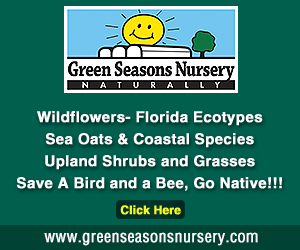FANN members, including some new members, came from as far as Tallahassee and Davie to hear the ornamental native gospel as spoken by Roger Triplett, Green Seasons Nursery, January 8, 2016, in Parrish. This was our association’s inaugural workshop in the new GrowNative series focused on native plant production methods for growers. Mark your calendar for the next workshop: April 29.
|
Finally! Laws and rules and advanced building codes classes will be on the agenda at the 4th Annual Native Plant Show this spring, thanks to a collaboration with DistanceLearnPro, a provider of both live and online education for industry professionals. Landscape architects can now get all the types of continuing education credits they need at the Native Plant Show.
|


National Pollinator Health Strategy commentary from scientists and others that you won’t see in Big Hort trade publications.
|
Please join us in welcoming new FANN members.
|
Sponsors and exhibitors can sign up online to be part of the show happening Thursday-Friday, March 31-April 1, 2016 at the Osceola Heritage Park in Kisssimmee.
|
January 2016
February 2016
February 11-12 – Jacksonville Landscape Show hosted by NEFNGLA
March 2016
March 21 – First Day of Spring
April 2016
April 22 – EARTH DAY
|
The first national study to map U.S. wild bees suggests they're disappearing in many of the country's most important farmlands--including California's Central Valley, the Midwest's corn belt, and the Mississippi River valley. If losses of these crucial pollinators continue, the new nationwide assessment indicates that farmers will face increasing costs--and that the problem may even destabilize the nation's crop production.
|
Environmental consciousness has solidly moved into the mainstream and it has penetrated every generation in some way. The Natural Marketing Institute claims that 83% of Americans are some shade of green. And a 2015 Tork Green Business survey indicated that 78% of American adults purchase green products and services. Concern for sustainability—the environment and for social issues—only seems to be rising. In a recent survey, 55% of Americans said they wish they did more for the environment (from Sustainability in America 2015: Trends & Opportunities). And the younger Millennial generation is even more concerned, with 77% saying they wish they did more. All of this is good news for native plant businesses.
|
Native landscaping strengthens the greater South Florida ecosystem by providing food and shelter for birds and butterflies. In the face of rising sea levels and climate change, natives boost migration outcomes for wildlife while reducing demands on natural resources. Check out the press our friends at the Institute for Regional Conservation got recently.
|
Efforts to find alternatives to costly or non-renewable potting media components have often gone hand in hand with efforts to find useful applications for agricultural by-products that would otherwise be treated as a waste liability. Peat has been a major potting media component for decades, but concerns over the environmental damage caused by its harvest have fostered a search for alternatives. Numerous problems are also associated with the storage and disposal of animal manure. Anaerobically digested dairy fiber (ADDF) has the potential to serve both as a replacement for peat in potting media and to reduce some problems associated with dairy manure.
|
World leaders have begun to get serious about fighting climate change, but we still face the incredible risk of a rising sea in this century and far into the future. According to Climate Central, a research organization, a 4-degree Celsius (7.2 degrees Fahrenheit) global temperature increase, which is our current path, could result in sea level rise that would submerge land where 470 – 760 million people now live.
|
Just because a residential landscape can provide ecosystems services that might provide public good, doesn’t mean the property owner values it. Quite simply, if it doesn’t look good, almost no one cares. Of course the real picture painted from the results of a multi-institutional National Science Foundation funded research study is more complex. If we’re going to invest millions, even billions, of dollars into green infrastructure for the ecosystems services it provides, then how do you motivate private landowners to play? First by understanding where they are now.
|
|
| |
|

